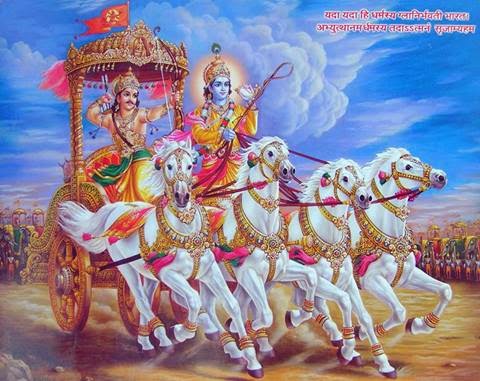The Difficulties of the Spiritual Seeker : 20.( Last part )
The Teachings of the Bhagavadgita :
It is a condition of further creation. There cannot be creation unless there is space-time; it is an antecedent to every concept of evolution in any manner whatsoever. When space-time is manifest or evolved by the will, as you may say of this cosmic self-consciousness, ahamkara, there is a further condensation into greater grossness, into more concrete vibrations which you call sensations of sound, of touch, of colour, of taste, and of smell. These principles which are behind these five sensations are called tanmatras in the Sanskrit language. A word used in Sanskrit, tanmatra, means the fundamental characteristic of all things in this world. Basically they are only sensations, which is what modern science also is telling us finally – the whole world is nothing but a huge bundle of sensations. The solidity is not the truth of things.
Now, there is a further condensation by a mixing up of these cosmical principles called tanmatras in certain proportions, and as a mixture is produced by an apothecary or a doctor by combining chemical products in some proportion and it becomes a medical mixture; in such a way or in some such manner these principles, these tanmatras, got combined and became gross elements in what are called ether, air, fire, water, and earth. These five gross elements are the whole world. In this world you will see nothing except these five elements – ether, air, fire, water, earth. Even this physical body of ours and everything that is physical and material in this world, all these are constituted of these five elements only. Here is the objective world before us, according to the Samkhya cosmological evolutionary process.
Subjectively, we are individuals looking at the world. We – not merely humans, everything that is capable of visualising the world as an external something – is a subject, even if it be subhuman or even superhuman. As this cosmical outward world is constituted in this manner described, the individual also is constituted in some way. The physical body of organic as well as inorganic beings is made up of the same five elements - earth, water, fire, air, and ether. But inside the body there are other things, deeper layers, internal and more pervasive, more ethereal – like electric energy you may say – than the physical body outside. We have the pranas inside. A prana is a vibratory motion of an energy which sustains us, and due to which we feel strength in our system. Internal to the pranas is the mind, which thinks. The senses – hearing, seeing, etc. – are intermediary operations between the prana and the mind. They are connecting links between the prana and the mind; they can be associated with the prana or associated with the mind as you like, or perhaps both.
But internal to the mind is understanding or the intellect, the reason which does not merely think in an indeterminate manner but determinately decides, judges, understands, and comes to a conclusion; that is reason – intellect. These layers mentioned are called, in Sanskrit, the koshas. Kosha means a cover, an investiture, an encasement. The physical body is called annamaya kosha because it is actually made up of the stuff of food that is taken inside. The pranas are called the pranamaya kosha. Internally we have got the manomaya kosha or the mind, then the vijnanamaya kosha or the intellect. Then there is a fifth one which is a causal condition, you call sometimes the unconscious level in psychology. It is something more than what you call the unconscious in ordinary psychology – it is the repository of all the conditions necessary for further reincarnations, into which you descend in deep sleep. Beyond that is the Atman, the pure spirit which is illuminating everything, whose reflection it is that is enabling the intellect to understand. So this is the subjective side, we may say – the subjective world.
The operation of this subjective world through the instrument of the mind, the intellect, and the senses, in contact with the objective world described, is what we call human experience as far as we are concerned. All of our experiences, desirable or undesirable, are the outcome of a peculiar coming in contact of the subjective world with the objective world. The reason behind this contact, and the nature of this contact was not clear to the mind of Arjuna, and is not clear to the mind of any one of us. This knowledge is called samkhya – right understanding.
Swami Krishnananda
The Difficulties of the Spiritual Seeker : ENDS.
Next : Samkhya – Right Understanding


.jpg)

Comments
Post a Comment